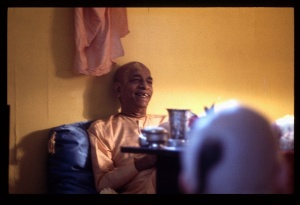SB 11.5.24

A.C. Bhaktivedanta Swami Prabhupada
Please note: The synonyms, translation and purport of this verse were composed by disciples of Śrīla Prabhupāda
TEXT 24
- tretāyāṁ rakta-varṇo 'sau
- catur-bāhus tri-mekhalaḥ
- hiraṇya-keśas trayy-ātmā
- sruk-sruvādy-upalakṣaṇaḥ
SYNONYMS
tretāyām — in Tretā-yuga; rakta-varṇaḥ — red-complexioned; asau — He; catuḥ-bāhuḥ — four-armed; tri-mekhalaḥ — wearing three belts (representing three phases of Vedic initiation); hiraṇya-keśaḥ — having golden hair; trayi-ātmā — personifying the knowledge of the three Vedas; srak-sruva-ādi — the sacrificial wooden ladle, spoon and so on; upalakṣaṇaḥ — having as His symbols.
Translation and purport composed by disciples of Śrīla Prabhupāda
TRANSLATION
In Tretā-yuga the Lord appears with a red complexion. He has four arms, golden hair, and wears a triple belt representing initiation into each of the three Vedas. Embodying the knowledge of worship by sacrificial performance, which is contained in the Ṛg, Sāma and Yajur Vedas, His symbols are the ladle, spoon and other implements of sacrifice.
PURPORT
The sruk is a particular implement for pouring ghee in sacrifices. It is about an arm's length long and is made of a particular type of wood called vikaṅkata. The sruk has a rodlike handle and a spout with a shallow groove at its tip that resembles a swan's beak. Its front part is a carved-out spoon the size of a fist. The sruva is another implement used in sacrificial oblations. It is made of khadira wood, is smaller than the sruk and is used to pour ghee into the sruk. It is also sometimes used instead of the sruk to pour ghee directly into the sacrificial fire. These are the Lord's symbols in Tretā-yuga, when the Lord incarnates to introduce the yuga-dharma of yajña, or sacrifice.